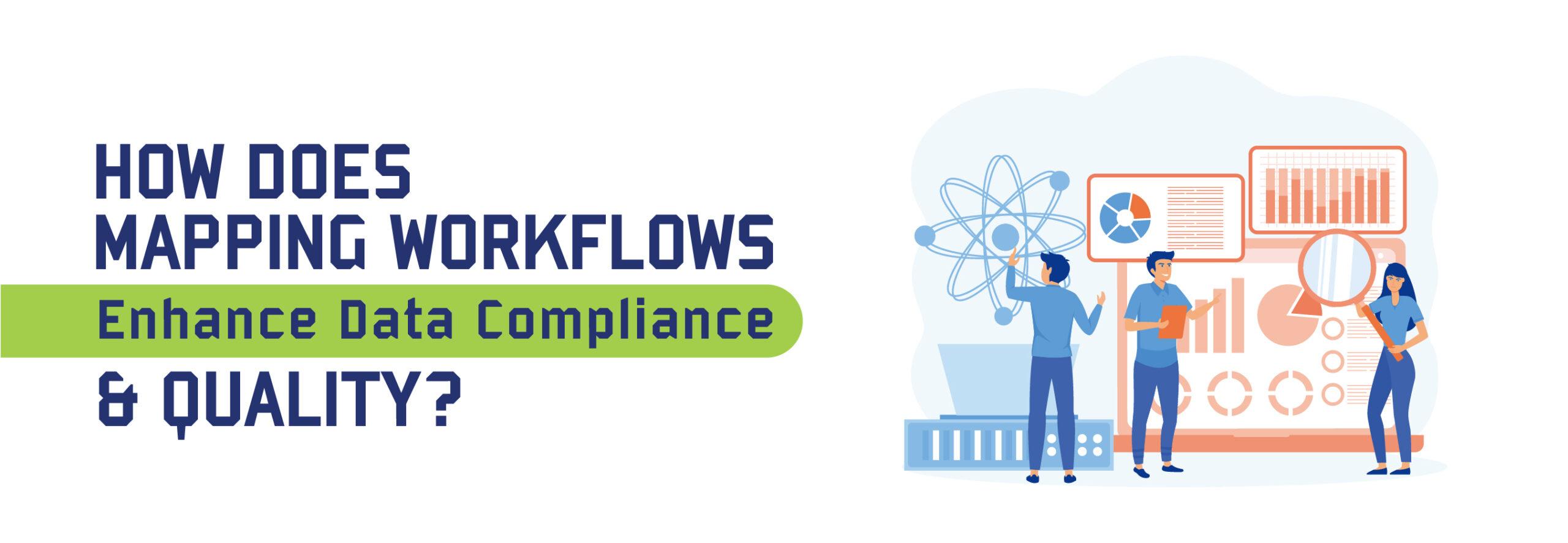
How Does Mapping Workflows Enhance Data Compliance & Quality?
In industries like healthcare, finance, and pharmaceuticals, strict data compliance and quality standards are final and non adjustable. GDPR and FDA regulation guidelines require accurate, auditable data handling. A single misstep can lead to heavy fines and reputational damage.
To solve these challenges, companies are turning to workflow mapping—a method of visually outlining and automating business processes, as illustrated in the image below. Workflow mapping helps organizations clearly define how data flows through each step, identify disorganization, comply with regulation standards, and ensure proper approval checkpoints are in place. This blog explores how workflow mapping enhances data compliance and quality.

Source Xpediant Digital
The Challenges of Data Compliance & Quality
Achieving reliable data compliance and quality is easier said than done. Organizations today face several challenges in these areas:
- Keeping Up with Regulations
Regulatory requirements are changing frequently. Finance and pharmaceutical industries have to comply with laws such as data privacy regulations and FDA marketing guidelines. Failure to comply charges in penalties; non-compliance costs businesses 2.7 times more than compliance—an average of $14.8 million vs. $5.5 million annually.
- Data Silos and Inconsistent Processes
Many enterprises suffer from fragmented systems and manual workflows. Data gets duplicated or isolated in departmental silos, leading to disorganization. Without a unified process, one team’s “approved” data may conflict with another’s records. These silos make it difficult to enforce company-wide data standards or maintain a single source of truth for audits.
- Manual Errors and Inefficiencies
When workflows are not mapped or automated, they rely on manual processes, increasing human errors like missing data fields, typos, or duplication. Inefficient workflows slow operations, forcing employees to spend time fixing errors instead of focusing on higher-value tasks. Segment estimates poor data quality costs the US economy $3.1 trillion annually in lost productivity, rework, and missed opportunities.
- Reputational Risk
Both compliance failures and data quality issues can erode trust. A regulatory breach or publicized data error (such as incorrect customer information or an unapproved marketing claim) can damage an organization’s reputation. Clients and regulators expect accurate, trustworthy data. One high profile mistake can make headlines and cause loss of customer confidence.
The good news? Workflow mapping provides a proactive solution that addresses these pain points by bringing order and accountability to how data is handled.
How Workflow Mapping Addresses These Challenges
Workflow mapping is the practice of laying out each step of a business process in a visual diagram or defined sequence. It’s essentially creating a blueprint of “who does what, when, and how” for a given workflow. This technique provides much-needed structure and clarity in complex data environments. By formally mapping workflows, organizations can proactively tackle the challenges mentioned above:
Clarity and Standardization
Workflow mapping visually outlines each step in a process, ensuring uniform execution. For example, mapping customer data workflows standardizes capture, validation, and storage. This reduces variation, ensuring compliance by following the same approved sequence. This consistency is key to both quality (everyone uses the same data definitions and checks) and compliance (required steps aren’t skipped).
Built-in Compliance Check
Mapped workflows embed compliance steps directly into operations. This ensures adherence to regulations while creating an automatic audit trail. For instance, a mapped content approval workflow can require that a manager and a compliance officer sign off before any marketing content is published. By designing the workflow with those approval nodes, it’s virtually guaranteed that unapproved content cannot go live because the process won’t move forward until the checkpoint is cleared.
Industry best practices for workflow governance recommend accurate record-keeping and audit trails be built into automated processes. This way, if regulators come knocking, the organization can show who handled the data and how it was handled at each step.
Error Reduction through Automation
Modern workflow mapping often goes hand in hand with automation. Once you’ve mapped a process, you can identify steps that can be handled by software – for example, automatically routing a document to the next approver or validating that a form is complete. By automating repetitive and rules-based tasks, you reduce the human error factor.
Improved Visibility and Accountability
Mapping defines roles, ensuring everyone knows their responsibilities. Issues are easily traced to their source, allowing quick resolution. Managers gain full visibility into process bottlenecks and data handling. This level of governance enhances operational efficiency and compliance.
Governance and Change Management
Mapping workflows makes it easier to update processes in response to new regulations or business needs. Changes can be implemented consistently without relying on informal updates. Teams can update automation and retrain staff with clear guidelines. This structured approach ensures ongoing compliance and process integrity.
How XpConnect® Acts as the “Connective Tissue” for Content Workflow
XpConnect® is an automation platform designed specifically for regulated industries to connect their content workflow. It serves as the “central hub” for your mapped workflows, ensuring that all the disparate tools and data involved in a process are linked together.
With XpConnect®, companies can integrate enterprise content management (for example, Adobe Experience Manager) with compliance and approval systems (such as Veeva Vault PromoMats) into one seamless workflow.
Importantly, it was built with data compliance and quality in mind. It establishes a single source of truth for digital assets and data across systems, eliminating the inconsistencies that come from having multiple versions of content in different places.
Learn how Bristol Myers Squibb, a global pharma leader, was able to streamline asset management and improve the quality of their MLR submissions with XpConnect®.

Key Benefits of Automating Workflows for Compliance & Quality
Mapping and automating workflows yields tangible benefits for organizations seeking better compliance and data quality. Some of the key advantages include:
- Every step in the data journey is documented, making audits faster and more efficient
- Standardized workflows reduce manual errors and ensure reliable, consistent data
- Automated checkpoints catch issues early, minimizing compliance risks
- Mapped workflows allow quick updates to meet evolving compliance requirements
- Transparent workflows enable regular refinements for better compliance and quality
By reaping these benefits, the end result is a business that runs smoothly, satisfies regulators and customers, and can trust in the integrity of its own data.
Ready to enhance your organization’s compliance and content quality through smarter workflows?
In a world where regulatory scrutiny and data-driven decision making are both intensifying, having rock-solid workflows is a major competitive advantage. Contact us if you’re interested in seeing a live demo of XpConnect® or would like to discuss your specific compliance challenges.




